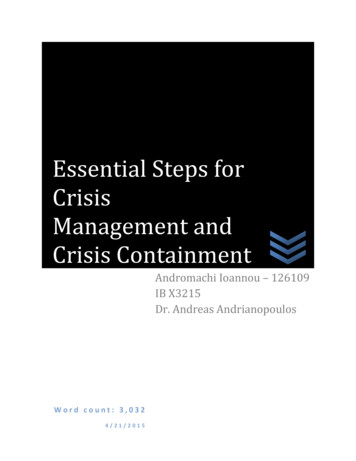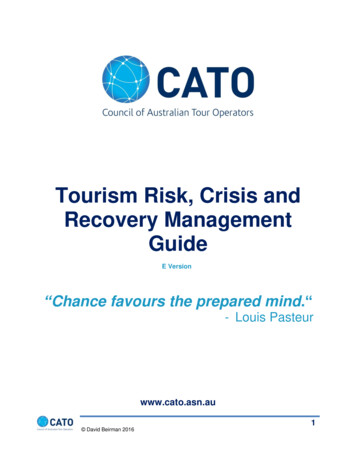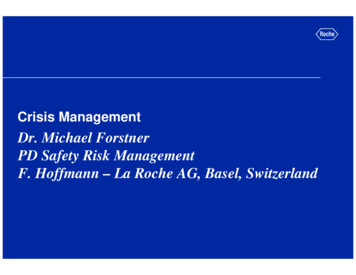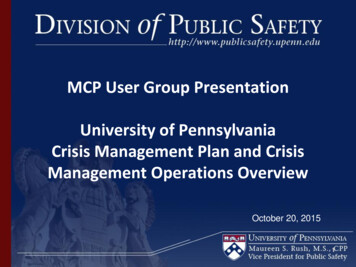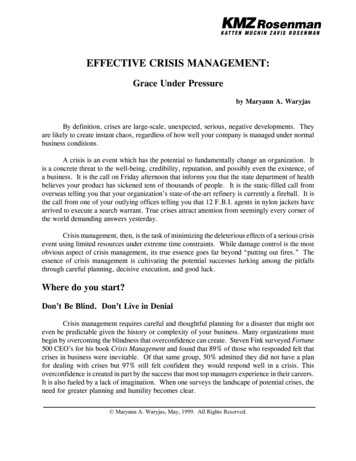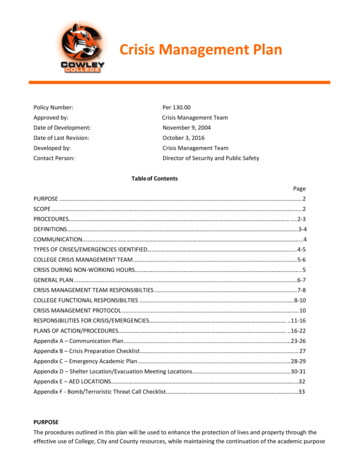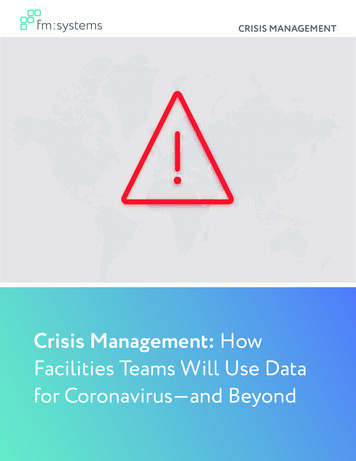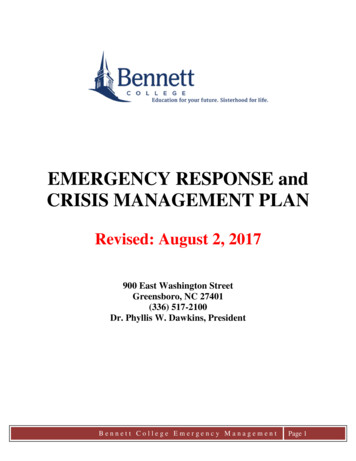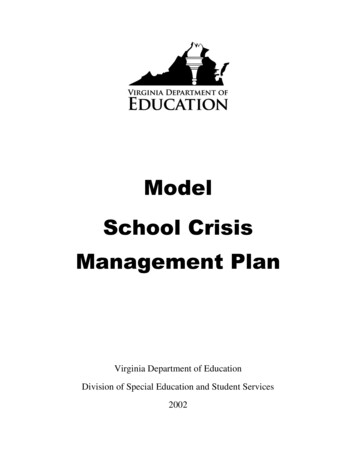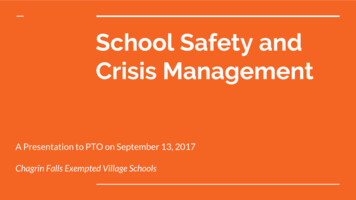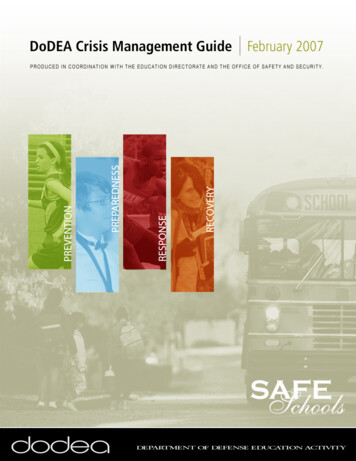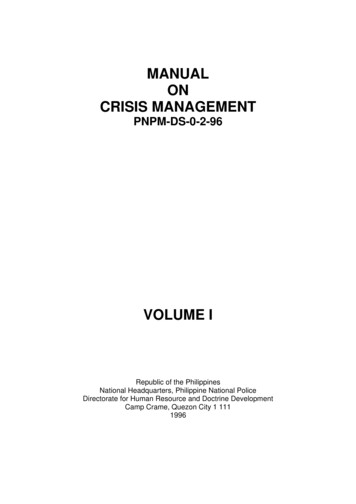
Transcription
MANUALONCRISIS MANAGEMENTPNPM-DS-0-2-96VOLUME IRepublic of the PhilippinesNational Headquarters, Philippine National PoliceDirectorate for Human Resource and Doctrine DevelopmentCamp Crame, Quezon City 1 1111996
TABLE OF CONTENTSPageCHAPTER 1, CRISIS MANAGEMENT CONCEPTSection I. GENERAL1-1. The Situation1-11-2. Purpose and Scope1-11-3. Crisis and Emergency1-11-4. Types of Crisis/Emergency1-3a. Man-Made Crises/Emergencies1-3b. Natural Crises/Emergencies1-41-5. General Tasking1-4Section II. CONCEPTUAL FRAMEWORK1-6. The 4P Crisis Management Model1-51-7. Phases of Crisis Management1-5a. Proactive Phase1-5(1) Prediction1-5(2) Prevention1-6(3) Prepare1-6b. Reactive Phase1-6(1) Initial Action1-7(2) Action1-7(3) Post Action1-8CHAPTER 2. CRISIS MANAGEMENT POLICIESSection I. NATIONAL POLICY2-1. Subscription to Anti-Terrorism Covenants2-12-12-2. Coordinated and Calculated ResponseAgainst Anti-Terrorism2-1
2-3. Terrorism Considered a Criminal Act2-12-4. Lawful Means and Peaceful Resolution To Conflict2-5. Crisis Situations Involving Foreign Nationals2-12-12-6. Involvement of Filipino Nationals in CrisisIncidents Abroad2-2Section II. DND-AFP/DILG-PNP POLICY2-7. General2-22-8. Graduated Armed Response2-22-9. Non-Compromise With Terrorists2-22-10. Handling Hostage Situations2-22-11. Respect for Human Rights2-32-12. Development of Nationwide CapabilityTo Cope with Crisis2-32-13. Handling of Crisis at Lowest Level Possible2-32-14. Organization of AFP/PNP Crisis ManagementReaction Units2-32-15. Development of AFP/PNP Anti-Terrorism Doctrines2-16. Guidelines in Addressing Crisis SituationArising from Threats to National SecurityPursuant to E.O. No. 216, s-19952-4CHAPTER 3. CRISIS MANAGEMENT PROCEDURESSection I. PRO ACTIVE PHASE3-1. Predicta. Intelligence3-13-2(1) Strategic Intelligence3-2(2) Tactical Intelligence3-2(3) Operational Intelligence3-3b. Events3-4c. Threat Analysis3-4d. Threat Groups3-42-3
(1) Broad Categories of Threat Groups3-4(2) Terrorists Characteristics3-5(3) Threat Characteristics Matrix3-6(4) Terrorists Goals3-11(5) Terrorists Groups3-12(6) Terrorists Operations3-13(7) Terrorists Tactics3-14(8) Terrorists Targets3-16e. Vulnerabilities3-18(1) Static Dimensions3-18(2) Dynamic Dimensions (Controllable)3-18(3) Dynamic Dimensions (Uncontrollable)3-18(4) Installation Vulnerability Factors3-183-2. Prevent3-19a. Operations Security .3-20b. Personnel Security3-20(1) Personnel Threat Assessment3-20(2) Personnel Security Program Preparation3-21c. Physical Security3-223-3. Prepare3-22a. Plan3-22b. Organize3-22c. Train3-22d. Equip3-24e. Maintain Readiness3-24(1) Organizational Readiness3-24(2) Operational Readiness3-24Section II. REACTIVE PHASE3-4. Initial Action Stage3-263-5. Action Stage3-27a. Negotiation3-27b. Tactical Action/Intervention Stage3-28
3-6. Post Action Stage3-28a. Processing and Debriefing3-28b. Protection of the Incident Scene3-28c. Investigation of the Incident3-29d. Documentation3-29e. Filing and Prosecution of Cases3-29f. Training and Restraining3-29g. Damage Compensation and Rehabilitation3-30CHAPTER 4. CRISIS MANAGEMENT ORGANIZATIONSection I. NATIONAL LEVEL ORGANIZATION4-1. General4-14-2. Peace and Order Council (POC)4-14-3. Crisis Management Committee4-14-4. AFP/PNP Organization at National Level4-3Section II. LOWER LEVEL CRISIS MANAGEMENTORGANIZATION4-5. Lower Level Peace and Order Council4-74-6. Lower Level Crisis Management Committee4-7a. Lower Level CMC Organization4-7b. Composition of Lower Level CMC4-7c. Functions of Lower Level CMC4-84-7. AFP/PNP Organizations at Lower Levels4-9a. Philippine National Police4-10b. Philippine Army4-10c. Philippine Air Force4-11d. Philippine Navy4-11
Section III. CRISIS MANAGEMENT ORGANIZATION4-8. Organizational Levels4-12a. National4-12b. Regional4-12c. Provincial4-13d. City/Municipal4-13e. On-Scene Command Post4-14f Crisis Management Action Groups4-14(1) Negotiation Group4-14(2) Operations Group4-14(3) Service Support Group4-14(4) Public Affairs Group4-154-9. Crisis Management Organization Ad Hoc Chart4-174-10. National Level Crisis Management Organization4-174-11. Provincial Level Crisis Management Organization4-184-12. City/Municipal Level Crisis Management Organization 4-184-13. Crisis Management Operation Center4-194-14. On-Scene Command Post4-204-15. Crisis Management Action Groups4-21A. Negotiation Group .4-21(1) Negotiation Team4-21(2) Liaison Team4-21b. Operations Group4-22(1) Security Units/Elements4-22(2) Tactical Action/Intervention Units4-23c. Service Support Group4-23(1) Legal/Investigation Team4-24(2) Intelligence Team4-24(3) Communication Electronics Team4-24(4) Logistics Team4-24(5) Medical Team4-24
(6) Fire-Fighting Team4-25(7) Administrative Support Team4-25d. Public Affairs Group4-25(1) Public Information Team4-25(2) Media Control Team4-25(3) Community Relations4-264-16. Inter-Agency Relationship at the Lower Levels4-26CHAPTER 5. HOSTAGE NEGOTIATIONSection I. HOSTAGE NEGOTIATION PROCEDURES5-15-1. Hostage-Taking Situation5-15-2. Categories of Hostages5-15-3. Categories of Hostage-Takers5-2a. Criminals5-2b. Mentally-Deranged Individuals5-2c. Terrorists5-25-4. Personality Types of Hostage Takersa. Most Common Disorders5-2b. Quick Recognition Points5-35-5. Tactics Against Hostage Takers5-3Section II. HOSTAGE NEGOTIATION CHECK-OFF LIST5-6. WHAT? (SITUATION)5-75-7. WHERE?5-85-8. WHO?5-85-9. WHEN?5-95-10. WHY?5-95-11. HOW?5-10
Republic of the PhilippinesDepartment of the Interior and Local GovermnentNational Police CommissionNATIONAL HEADQUARTERS PHILIPPINE NATIONAL POLICECamp Crame, Quezon CityMEMORANDUMTO:SUBJECTDATEAll Concerned::LETTER OF PROMULGATIONMarch 16, 1996PNPM-D-O-2-96 (DHRDp) Manual on Crisis Management is validated andpublished by the Directorate for Human Resource and Doctrine Development, PNPin coordination with the Directorial Stafl’ tested and evaluated by the Regional PoliceCommands and National Support Units.This manual is hereby promulgated for the information and guidance of allconcerned effective this date.RECAREDO A SARMIENTO IIPolice Director GeneralChief, PNP
FOREWORDThe primary concern of the police is crime prevention. Foremost is thepreservation of life, protection of property and environment. The Police in the pursuitof his mission, oftentimes is confronted by situations when least expected unusualphenomena apparently result into crisis.Natural or man-made they maybe, the police officer must be able to know theconcepts, policies and general procedures of handling crisis situations arising fromthe actions of the criminals, terrorist elements, or mentally deranged individuals whouse violence, threats and illegal acts to pursue their ends.This manual provides for the conceptual framework in Crisis ManagementModel which is envisioned to address crisis situations resulting from peace and orderproblems such as terrorism and criminality.Also, this manual is designed to provide clear understanding of the interdependencyof roles of the PNP, AFP and LGUs in the management and handling of crisis atlowest level possible.Any suggestions or recommendations to improve this publication is highlyencouraged. Please course through the Director, Directorate for Human Resourceand Doctrine Development.CRISOGONO REBA FRANCISCOPolice Chief Superintendent, (MNSA)Director, Directorate for HumanResource and Doctrine Development
CHAPTER ICRISIS MANAGEMENT CONCEPTSSection 1. GENERAL1. The Situation:Being located along the circum-Pacific rim of volcanoes and typhoons, thePhilippines plays host to a procession of natural disasters. Volcanic eruptions,earthquakes, typhoons and tsunamis regularly wreak havoc on lives and properties.Aggravating these natural disasters are man-madedisturbances, terrorist activities, hijacking and hostage-taking.oneslikecivilSuch disasters naturally cause public anxiety, loss of lives and properties andcause embarrassment to the government.Somehow, these crises situations may be predicted, prevented or theiradverse effects minimized.1-2. Purpose and Scope:This document sets the concept, policies and general procedures for handlingcrisis situations to guide and assist all concerned agencies in formulating theirrespective crises management contingency plans and standard operatingprocedures (SOPs) to address threats peculiar to them.This doctrine specifically addresses man-made crisis situations arising out ofthe actions of criminals, terrorist elements, or mentally-deranged individuals who useviolence or threat of violence to pursue their ends.Relatedly, the AFP/PNP, by virtue of their respective mandates, capabilitiesand resources become the primary “intervention agencies” which can neutralize theperpetrators.I-3 Crisis and EmergencyCrisis, came from the Greek word crisis, which means to separate. As definedWagnalls, crisis is a turning point in the progress of an affair or a series of events.Through crisis is often used interchangeably with emergency, and crisisdevelop from an emergency and vice versa, these terms have certain degree ofdifference. Emergency came from the Latin word emergentia meaning a dipping;plunging. Funk and Wagnalls defined emergency as a sudden condition or state ofaffairs calling for immediate action.
The following schematic diagram further illustrates the difference betweencrisis and emergency (FIG 1):CRISISProgressive sequence of eventsBuild up of instabilityGrowth of tensionTurning en and/orUnforeseenEvent(s) orState of affairsImmediate ionCRISISEMERGENCYFigure 1. Difference between Crisis and Emergency1.1Types of Crisis/EmergencyCrises or emergencies are either man-made or natural, and categorized asfollows:a.(1)Man-Made Crises/EmergenciesCivil disturbance(a) Violent labor strikes(b) Riots
(c) Anarchy(d) Disorderly Mass Demonstrations(2)Revolt(a) Mutiny(b) Insurrection(c) Coup d etat(3)(4)(5)RevolutionBoarder incidentWara. Conventionalb. Nuclear(6)(7)KidnappingHijacking(a) Air(b) Sea(c) Land(8)(9)(10)(b)Hostage-takingTerroristic activities (bombing, arson, assassination/liquidation,extortion, intimidation, etc.)Attacks/raids on government installations/ facilities and vital facilitiesNatural 11)(12)(13)(14)(15)FireMarine/Air DisastersStructural collapseHazardous spillsUtilities failure (power, water, telephone)Nuclear accidentsFood Scarcity/famineFuel shortage ic EruptionEarthquake TsunamiTidal WaveTyphoonsDrought
1.5. General Tasking:When a crisis arises out of man-made emergencies as described above, thePeace and Order Council at the appropriate level shall be the organizational bodythat shall primarily act on the crisis situation.When a crisis results from aircraft hijacking, disturbances in the civil aviation,or terrorism that has national significance, the National Action Committee on AntiHijacking and Anti-Terrorism (NACAHT) shall principally deal with the crisis situation.When crises occurs as a result of natural disasters or calamities, theorganization that shall primarily address the same will be the National DisasterCoordinating Council and its subordinate entities. The disaster managementactivities :n this regard shall then be governed separately by Presidential Decree No.1566 dated June 11, 1978 and its implementing rules, regulations and policies.This manual applies to crisis situation resulting from peace and orderproblems as terrorism and criminality.Section II. CONCEPTUAL FRAMEWORK1-6The 4P Crisis Management ModelCrisis incidents occur when thy are least expected. What make theseincidents me crises situations is when they go out of control and cause destruction tolives property or endanger public safety. The 4P Crisis Management Model isenvisioned dress crises situations in two-phases the Proactive and the Reactive infour Prediction, Prevention, Preparation andPerformance.1-7Phases of Crisis ManagementCrisis management is continuing activity that has two distinct phases: Themay and the Re-active phase.a.The Proactive Phase. This phase is designed to predict or prevent theprobability of occurrence the same time prepare to handle them when they occur. Itencompasses 3Ps of the 4P Crisis Management Model prediction, prevention(1) PredictionThis stage involves foretelling of the likelihood of crises occurring or manmade through the continuous assessment of the all possible threats and threatsgroups, as well as the analysis of developing or reported events and incidents.Crises incidents can be predicted through updated inputs from intelligence reports aswell as the continuous monitoring and analysis of the confluence of related events.In case of man-made crises/emergencies, and some natural crises/emergencies, this stage requires continuous study of the targets of existing threats,specifically the threat groups, their probable targets and the vulnerabilities of criticalinstallations and facilities.
All threats and threat groups should be considered whether they are internalor external to any organization or facility.(2) PreventionWhen most man-made crises/emergencies, this stage involves the institutionof passive and active security measures, as well as the remedy or solution ofdestabilizing factors and/insecurity flaws leading to such crises/emergencies.On the other hand, most natural crises/emergencies at this stage requirevigilance and alertness to signs and manifestations of developing crises/emergencies. Warning/alert systems have to be established to increase the chancesor odds of preventing the occurrences of crises/emergencies.Preventive actions may well be applied to both natural and manmadecrises/emergencies to prevent them from developing to uncontrollable proportions.(3) PreparePreparation for crises/emergencies entails planning, organization, training andstockpiling of equipments and supplies needed for such crises/emergencies.Sim
CRISIS MANAGEMENT PNPM-DS-0-2-96 VOLUME I Republic of the Philippines National Headquarters, Philippine National Police Directorate for Human Resource and Doctrine Development Camp Crame, Quezon City 1 111 1996 . TABLE OF CONTENTS Page CHAPTER 1, CRISIS MANAGEMENT CONCEPT Section I. GENERAL 1-1. The Situation 1-1 1-2. Purpose and Scope 1-1 1-3. Crisis and File Size: 839KBPage Count: 74
